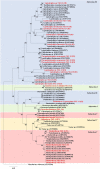Cyanobacterial Community Structure and Isolates From Representative Hot Springs of Yunnan Province, China Using an Integrative Approach
- PMID: 35547135
- PMCID: PMC9083006
- DOI: 10.3389/fmicb.2022.872598
Cyanobacterial Community Structure and Isolates From Representative Hot Springs of Yunnan Province, China Using an Integrative Approach
Abstract
Cyanobacteria from the representative hot springs of Yunnan Province, China are explored for their diversity and community composition following an integrative approach of cultivation-independent and -dependent studies and further isolation of potential taxa for future biotechnological perspective. 16S rRNA amplicon sequencing of microbial mats in these hot springs with temperature ranging from 38 to 90°C revealed Cyanobacteria and Proteobacteria constituting a bounteous portion of the bacterial community. The combined approach of 16S rRNA amplicon sequencing and phenotypic analysis revealed the diversity of cyanobacteria (a total of 45 genera). Out of these, a total of 19 cyanobacterial taxa belonging to 6 genera and 10 species were isolated as individuals with the possibility of biotechnological utilization. These isolates were subjected to a thorough morphological study and molecular characterization using 16S rRNA gene sequencing for identification and understanding their phylogeny. The identity and phenotypic and genotypic characteristics of 7 cyanobacterial isolates are not identical to any known cyanobacterial species, generating scope for future taxonomic novelties. Preliminary experiments based on high-temperature (50°C) cultivation showed that most of the isolates were thermotolerant and suggested for their high biotechnological usage potential.
Keywords: 16S rRNA amplicon sequencing; cyanobacteria; hot springs; phenotype; phylogenetics.
Copyright © 2022 Keshari, Zhao, Das, Zhu and Lu.
Conflict of interest statement
The authors declare that the research was conducted in the absence of any commercial or financial relationships that could be construed as a potential conflict of interest.
Figures








Similar articles
-
Bacteria and Archaea diversity within the hot springs of Lake Magadi and Little Magadi in Kenya.BMC Microbiol. 2016 Jul 7;16(1):136. doi: 10.1186/s12866-016-0748-x. BMC Microbiol. 2016. PMID: 27388368 Free PMC article.
-
Diverse Microbial Hot Spring Mat Communities at Black Canyon of the Colorado River.Microb Ecol. 2023 Oct;86(3):1534-1551. doi: 10.1007/s00248-023-02186-x. Epub 2023 Feb 9. Microb Ecol. 2023. PMID: 36757423 Free PMC article.
-
Microbial Diversity of Terrestrial Geothermal Springs in Armenia and Nagorno-Karabakh: A Review.Microorganisms. 2021 Jul 9;9(7):1473. doi: 10.3390/microorganisms9071473. Microorganisms. 2021. PMID: 34361908 Free PMC article. Review.
-
Morphological and phylogenetic diversity of thermophilic cyanobacteria in Algerian hot springs.Extremophiles. 2014 Nov;18(6):1035-47. doi: 10.1007/s00792-014-0680-7. Epub 2014 Jul 31. Extremophiles. 2014. PMID: 25078728
-
Untapped bacterial diversity and metabolic potential within Unkeshwar hot springs, India.Arch Microbiol. 2018 Jul;200(5):753-770. doi: 10.1007/s00203-018-1484-4. Epub 2018 Feb 2. Arch Microbiol. 2018. PMID: 29396619
Cited by
-
Association of Acidotolerant Cyanobacteria to Microbial Mats below pH 1 in Acidic Mineral Precipitates in Río Tinto River in Spain.Microorganisms. 2024 Apr 19;12(4):829. doi: 10.3390/microorganisms12040829. Microorganisms. 2024. PMID: 38674771 Free PMC article.
-
Superior Resolution Profiling of the Coleofasciculus Microbiome by Amplicon Sequencing of the Complete 16S rRNA Gene and ITS Region.Environ Microbiol Rep. 2025 Feb;17(1):e70066. doi: 10.1111/1758-2229.70066. Environ Microbiol Rep. 2025. PMID: 39890997 Free PMC article.
-
Community structure of thermophilic photosynthetic microbial mats and flocs at Sembawang Hot Spring, Singapore.Front Microbiol. 2023 Jun 16;14:1189468. doi: 10.3389/fmicb.2023.1189468. eCollection 2023. Front Microbiol. 2023. PMID: 37396374 Free PMC article.
-
Baseline metagenome-assembled genome (MAG) data of Sikkim hot springs from Indian Himalayan geothermal belt (IHGB) showcasing its potential CAZymes, and sulfur-nitrogen metabolic activity.World J Microbiol Biotechnol. 2023 May 3;39(7):179. doi: 10.1007/s11274-023-03631-2. World J Microbiol Biotechnol. 2023. PMID: 37133792
-
Diversity and networking of uni-cyanobacterial cultures and associated heterotrophic bacteria from the benthic microbial mat of a desert hydrothermal spring.FEMS Microbiol Ecol. 2024 Nov 23;100(12):fiae148. doi: 10.1093/femsec/fiae148. FEMS Microbiol Ecol. 2024. PMID: 39557663 Free PMC article.
References
-
- Bateson M. M., Wiegel J., Ward D. M. (1989). Comparative-analysis of 16s ribosomal-RNA sequences of thermophilic fermentative bacteria isolated from hot-spring cyanobacterial mats. Syst. Appl. Microbiol. 12 1–7. 10.1016/S0723-2020(89)80034-7 - DOI
-
- Brito Â, Gaifem J., Ramos V., Glukhov E., Dorrestein P. C., Gerwick W. H., et al. (2015). Bioprospecting Portuguese Atlantic coast cyanobacteria for bioactive secondary metabolites reveals untapped chemodiversity. Algal Res. 9 218–226. 10.1016/j.algal.2015.03.016 - DOI
LinkOut - more resources
Full Text Sources

